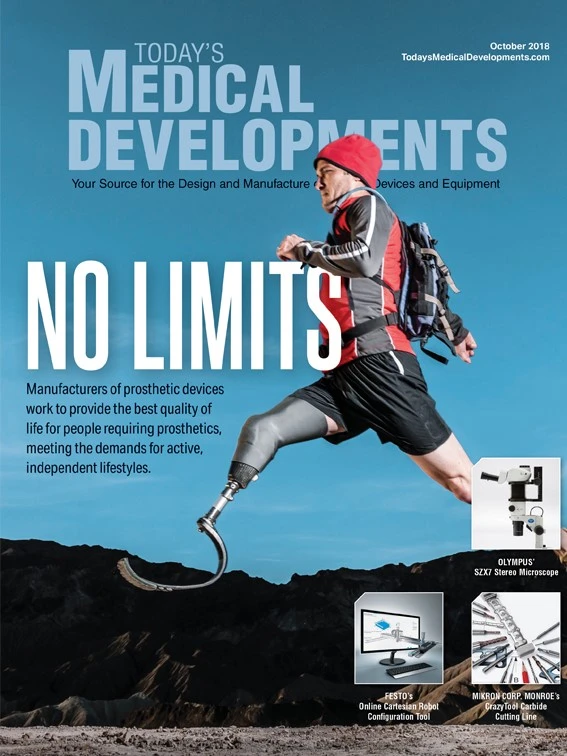The International Titanium Association’s (ITA) Medical Technologies Committee (MTC)
Medical applications for titanium, most notably in joint replacements, bone reinforcements, and dental applications, have been gaining momentum for several years, and the MTC believes its updated strategic plan is a way to re-evaluate medical as an emerging market by exploring AM to develop customized implants.
MTC Co-Chairman Viv Helwig, founder of Vested Metals Inc., explains that the MTC will explore AM technology, and study means using new alloys and smaller material lots to target implants with greater osseointegration and bio-compatibility.
Distributors can play a role by providing specific alloy grades and servicing subcontract manufacturers, Helwig explains. Distributors must deliver consistent material, compensating for the clinical nature of the titanium industry, which can lead to long lead times and supply constraints. Because titanium competes with stainless/cobalt alloys, Helwig said distibutors can balance inventories to the correct type and service customers.
MTC Co-Chairman Stephen R. Smith, president of Edge Int’l, says he and Helwig hope to educate the market on the opportunities for AM. Smith sees the potential for titanium in spinal implants and facial/cranial implants, especially jaw reconstruction. He adds that titanium will remain a strong player in the medical market for the foreseeable future due to its light weight, resistance to body fluids, biocompatibility, and it being a non-ferromagnetic metal (for MRI safety).
International Titanium Association (ITA)c Titanium Asia 2018
As a speaker at the Titanium Asia conference and exhibition, Co-Chairman Stephen R. Smith, president of Edge Int’l presented various topics.
Titanium Technology in Medical Applications
“The future for medical grade titanium looks bright,” Smith says. “The aging baby boomer demographic wants to stay active. The health industry is pushing all ages to lead more active lives … The medical industry will continue researching innovative uses for titanium. Distributors play a key role in the medical grade titanium supply chain.”
The role of the Distributor for Medical Grade Raw Materials
For customers of medical grade raw materials, Smith says there are five major original equipment manufacturers (OEMs), representing 59% of the worldwide market with in-house manufacturing, supplemented by contract manufacturers. By comparison, there are fewer than 100 smaller OEMs with limited in-house production capabilities, which predominantly use contract manufacturers.
“Distributors play a key role in the medical grade raw material supply chain,” Smith declares. He noted that distributors provide value-added services such as just-in-time delivery to manage inventory costs, precision grinding and sawing, small quantities for prototyping, and supplying non-standard grades of material.
Defining the role of the distributor, Smith urges OEMs to “work with a distributor on blanket orders whenever possible. This commitment allows the distributor to negotiate long-term price agreements and raw material hedge contracts with the mills, thereby letting the distributor offer firm pricing, with material always available on the shelf, for delivery as needed to meet your production schedule.”
Titanium USA At last year’s Titanium USA gathering, other experts shared presentations on their opinions that contributed to titanium’s business opportunities in the global medical sector.
Dynamics Impacting the Orthopedic Industry – Don Urbanowics, principal at Ubanowicz Consulting LLC, projects that orthopedic product sales – joint reconstruction, spine, trauma, arthroscopy/soft tissue, and orthobiologics – will reach an estimated $49.8 billion in 2017, $51.5 billion in 2018, and will climb to $57.3 billion by 2021, presenting growth-market opportunities.
Urbanowicz says AM would be appealing to surgeons for solving complex trauma and joint replacement cases. He also considered if 3D printing might “disrupt the current business model by eliminating off-the-shelf implants and instead be printed by hospitals.”
The Role of Titanium in Implant Dentistry
He confirms that titanium is the “de facto metal of choice in implant dentistry,” due to its superiority in resisting corrosion and toxicity in tissues, lack of allergic reaction and mechanical strength.
“Commercially pure titanium has the highest resistance to corrosion and is often regarded as the most biocompatible metal due to its stable/inert oxide layer,” Gubbi says. “More than 50 years of clinical research with higher than 95% overall success/survival rate make dental implants the best option for replacing missing teeth.”
Opportunities for Materials Innovation in Orthopedics – Dean Hutchinson, product manager, Arthrex Shoulder Arthroplasty, said the typical cost of an arthroplasty procedure – the surgical reconstruction/replacement of a joint to relieve pain and restore range of motion – is $40,000 for a hip, $35,000 for a knee, and $21,000 for a shoulder.
Hutchinson emphasized titanium’s properties as being perfectly matched for on-growth fixation to bones. Clinicians and original equipment manufacturers are “truly passionate” about titanium’s advantage. He suggested that producers of titanium implants consider working with coatings suppliers to develop products with enhanced antimicrobial properties and on-growth compatibility with bones.
Titanium Europe X-ray of back showing a spinal column with implant. Titanium Europe featured additional insights. Development of Pure Titanium-Based, High-Strength Wires; Possibilities for the Medical Industry
Comtes FHT’s Conform SPD technology, typically used for continuous extrusions of various profiles from nonferrous alloys, is used for producing nanostructured, high-strength wires. Palan says the company has developed a system for combining Conform SPD with equal-channel angular pressing (ECAP), providing a process for the cold extrusion of titanium. As a result, the nanostructured CP titanium retains its biocompatibility combined with higher strength than a Ti6Al4V alloy.
Achieving improved mechanical properties, combined with titanium’s inherent biocompatibility, enables designers to create smaller, stronger medical implants. “This is a product with high added value, where the use of nanostructured (CP) titanium delivers improved properties, and therefore increases the price,” Palan says. “However, the effect of the higher material prices on total manufacturing costs will be minimal.”







